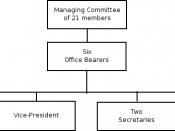Summary: The article "Lijjat Papad" describes the successful entrepreneurial venture set up by seven semiliterate women from a small community in rural India. The article gives an account of the setting up and functioning of the Sri Mahila Griha Udyog Lijjat Papad (SMGULP). It charts the growth of the organization and shows how it became worth Rs. 3 billion in four decades. The objectives of the organization and its core values and principles have also been discussed.
This is a unique organisation. A perfect "rag to riches" story. It is an organisation that worlds best B-schools study.
Shri Mahila Griha Udyog Lijjat Papad - the makers of the spicy indian bread.
A little background of this organisation -
Started with a modest loan of Rs 80 ($2 CDN), the cooperative now has annual sales exceeding Rs 301 crore (Rs 3.1 billion) ($75,250,000 CDN). With no idea of complex business models, the Lijjat ladies keep things simple.
1. Money management - One day at a time:
All the accounts are squared off on daily basis and transactions done in cash. No credit is asked for and none is extended. Distributors and exporters pick up their requirements on a daily basis against immediate payment. Even Lijjat's own branches have to pay the head office in cash for materials used everyday! Everyone including the president is paid a vanai or a daily wage. All the members are equal owners and share profits equally at the end of the year.
2. Workforce - Transparent corporate democracy:
Everyone at Lijjat begins as a papad roller. President Jyoti Naik joined as a papad roller herself. It's taken them 43 years to grow from a group of seven to a 42,000-strong organisation. This organisation is entirely owned by women, majoirty of whom are illitrate. The...


